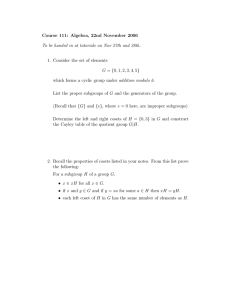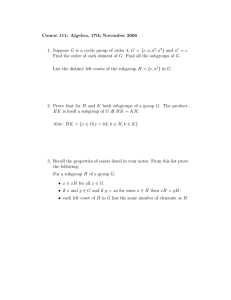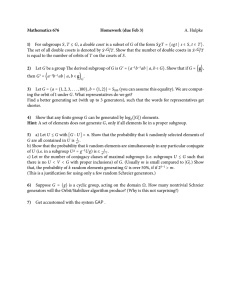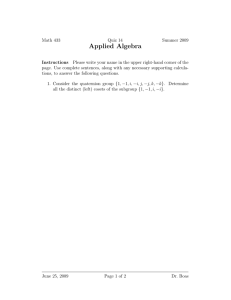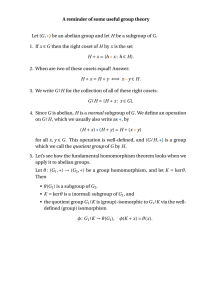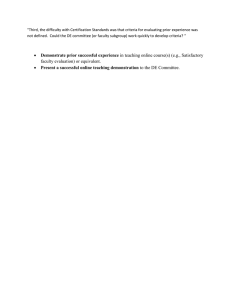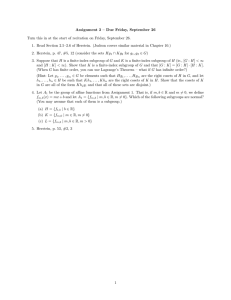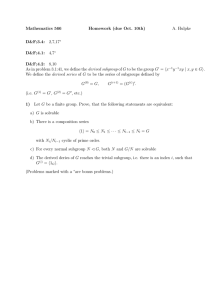Homework 2 – Solutions
advertisement
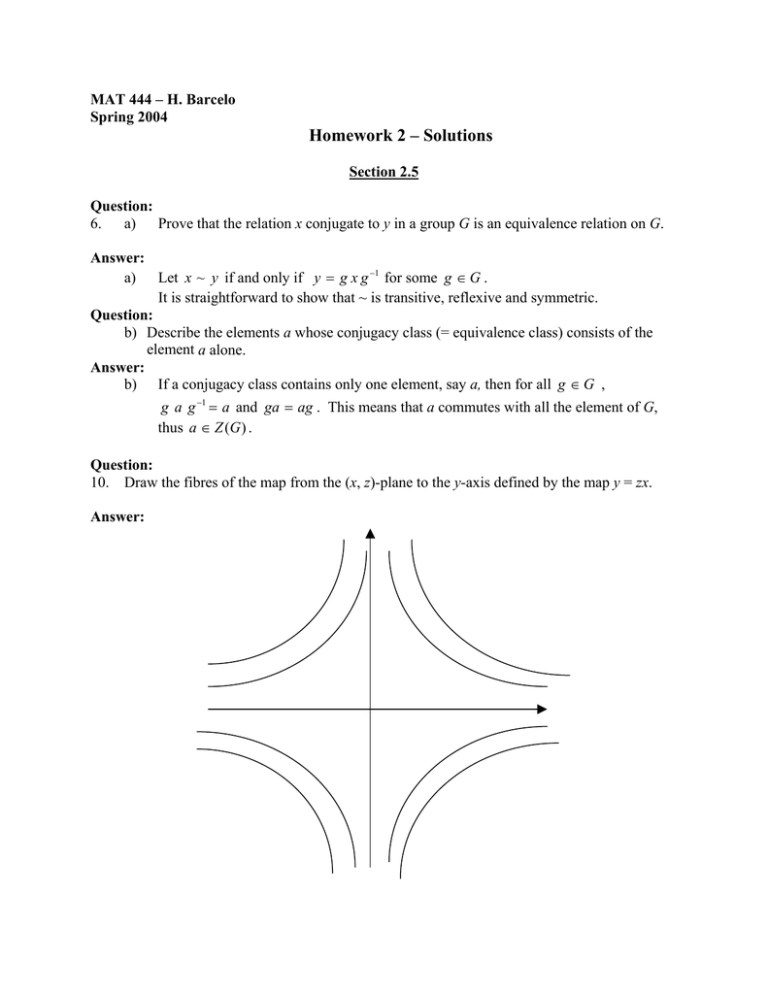
MAT 444 – H. Barcelo
Spring 2004
Homework 2 – Solutions
Section 2.5
Question:
6.
a) Prove that the relation x conjugate to y in a group G is an equivalence relation on G.
Answer:
a) Let x ~ y if and only if y = g x g −1 for some g ∈ G .
It is straightforward to show that ~ is transitive, reflexive and symmetric.
Question:
b) Describe the elements a whose conjugacy class (= equivalence class) consists of the
element a alone.
Answer:
b) If a conjugacy class contains only one element, say a, then for all g ∈ G ,
g a g −1 = a and ga = ag . This means that a commutes with all the element of G,
thus a ∈ Z (G ) .
Question:
10. Draw the fibres of the map from the (x, z)-plane to the y-axis defined by the map y = zx.
Answer:
MAT 444 – Barcelo
Homework 2
Page 2
Section 2.6
Question:
10. a) Prove that every subgroup of index 2 is normal.
Answer:
a) Let G be a group and H be a subgroup of index 2. H partitions G into 2 left cosets H
and aH, and similarly H partitions G into 2 right cosets, H, Ha.
If a ∈ H then aH = H = Ha since H is a subgroup of G.
If a ∈ G − H then aH = G − H = Ha .
Thus, aH = Ha for all a ∈ G , and H is normal in G.
Question:
b) Give an example of a subgroup of index 3 which is not normal.
Answer:
b) Let G = S3 and H = {1, (12)} a subgroup of index 3. Then
(123) H = {(123), (13)} and H (123) = {(123), (12)} , thus (123) H ≠ H (123) and H is
not normal.
Question:
11. Classify groups of order 6 by analyzing the following three cases.
a) G contains an element of order 6.
Answer:
a.) If G = 6 and G contains an element g of order 6 then G = g .
Question:
b) G contains an element of order 3 but none of order 6.
Answer:
b) If G = 6 and G contains an element g of order 3 but no element of order 6, then
H = {1, g , g 2 } = g is a subgroup of G and thus partitions G into 2 right cosets, H
and Hb = {b, gb, g 2b} where b ∉ H . The order of b has to divide 6, the order of G.
So b = 1, 2, or 3 . Since b ∉ H , b ≠ 1 , so b = 2 or 3 . If b = 3 then b 2 ≠ 1 .
Moreover, one sees that b 2 ≠ g , for if b 2 = g then
(b 2 ) 2 = g 2 and b 4 = b3 ⋅ b = g ⇒ b = g , contradicting the assumption that b ∉ H .
Equally, straightforward arguments yields that b 2 ≠ g 2 , b, gb, g 2b .
Thus, b ≠ 3, and b = 2 .
Next, since H has index 2 then Hb = bH , and {b, gb, g 2b} = {b, bg , bg 2 } .
Again we look at the various cases
Typeset by Georgeann Lorentz
MAT 444 – Barcelo
Homework 2
Page 3
If gb = bg , then ( gb) 2 = g 2b 2 = g 2 ; ( gb)3 = b .
( gb) 4 = g ; ( gb)5 = g 2b . Hence gb = 6 , which contradicts the assumption that
there was only one element of order 6. So gb = bg 2 and we have that
G = {1, g , g 2 , b, gb g 2b} with g = 3, b = 2 and gb = bg 2 ;
Hence G ≈ S3 .
Question:
c) All elements of G have order 1 or 2.
Answer:
c) If all elements have order 1 and 2, then G would be of the form
{1, g1 , g 2 , g3 , g 4 , g5 } with gi2 = 1 for all 1 ≤ i ≤ 5 .
Let H = g1 = {1, g1} . Then {G : H ] = 6 / 2 = 3 .
Thus we should have 3 distinct left cosets. But the 5 cosets:
gi H = {gi , gi g1} for 1 ≤ i ≤ 5 are distinct for gi ≠ g j for all i ≠ j . Since H
partitions G and gi H ≠ g j H we must have gi H ∩ g j H = ∅ . But then
G = 6 × 2 = 12 , contradicting our hypothesis that G = 6 .
Section 2.7
Question:
3. a.) Let H and K be subgroups of a group G. Prove that the intersection xH ∩ yK of two
cosets of H and K is either empty or else is a cost of the subgroup H ∩ K .
Answer:
a.) First note that since H and K are subgroups of G , H ∩ K is also a subgroup. If
x H ∩ yK = ∅ , we are done. If not, let g ∈ xH ∩ K . Since g ∈ xH and yK we
have that gH = xH and gK = yK . Thus xH ∩ yK = gH ∩ gK . It is then
straightforward to show that g ( H ∩ K ) = gH ∩ gK .
Question:
b) Prove that H and K have finite index in G then H ∩ K also has finite index.
Answer:
b) From (a) we have that all left cosets g ( H ∩ K ) are simply intersections of left cosets
of H and left cosets of K. Thus the total number of left cosets of H ∩ K is finite.
Typeset by Georgeann Lorentz
MAT 444 – Barcelo
Homework 2
Page 4
Section 2.8
Question:
3. a) Prove that a finite cyclic group of order rs is isomorphic to the product of cyclic
groups of orders r and s if and only if r and s have no common factor.
Answer:
a) Let Crs = {1, g , g 2 ,… , g rs −1} , Cr = {1, a,… , a r −1} and C p = {1, b,… , b s −1} . Define
ϕ : Crs → Cr × Cs
ϕ ( g i ) = (a i , bi ) .
by
First you should show that φ is well defined, that is if
g i = g j then ϕ ( g i ) = ϕ ( g j ) . Next, since
ϕ (gi ⋅ g j ) = ϕ (gi + j )
= ( a i + j , bi + j )
= (a i , bi ) (a j , b j )
= ϕ (g i )ϕ (g j ) ,
we have that φ is an homorphism.
Since C rs = Cr × Cs it suffices to show that the ker ϕ = 1 ⇔ gcd(r , s ) = 1 , for
proving that φ is an isomorphism. Recall that
ker ϕ = {g i ϕ ( g i ) = (a i , bi ) = (1, 1)} .
Thus g i ∈ ker ϕ ⇔ a i = 1 and bi = 1.
⇔ i = mr and i = ns
⇔ i = p ⋅ cm (r , s )
If gcd(r , s ) = 1 then i = prs and g i = ( g rs ) p = (1) and ker ϕ = 1 . Conversely if
ker ϕ = 1 then (a i , bi ) ≠ (1, 1) ∀ 1 ≤ i < rs , which means there are no integers < rs,
that are a multiple of both r and p ⇒ cm(r , s ) = rs ⇒ gcd(r , s ) = 1 .
Question:
7. a.) Let H and K be subgroups of a group G. Show that the set of products
HK = {hk h ∈ H , k ∈ K } is a subgroup if and only if HK = KH .
Answer:
a.) Assume HK is a subgroup of G, and let x ∈ HK . Then
x −1 = hk ∈ HK for some h ∈ H and k ∈ K . But x = ( x −1 ) −1 = k −1h −1 ∈ KH .
Similarly one shows that if y ∈ KH then y ∈ HK , thus HK = KH .
Typeset by Georgeann Lorentz
MAT 444 – Barcelo
Homework 2
Page 5
Next assume that HK = KH . We want to show that HK is a subgroup of G.
Since H and K are subgroups 1 ∈ H and 1 ∈ K ⇒ 1 ∈ HK .
Let x, y ∈ HK then x = hk and y = h′k ′ for some h, h′∈ H and k , k ′∈ K .
Hence, since HK = KH , xy = hkh′k ′ = hh∗ k ∗ k ′ for some h∗ ∈ H and k ∗ ∈ K . But
then hh∗ ∈ H and k ∗k ′∈ K ⇒ xy ∈ HK . Lastly, if
x ∈ HK , then x = hk and x −1 = k −1h −1 . But again since HK = KH , there exists
h∗ ∈ H and k ∗ ∈ K such that x −1 = h ∗k ∗ ∈ HK .
Question:
b)
Give an example of a group G and two subgroups H, K such that HK is not a
subgroup.
Answer:
b)
Let G = S3 , H = {1, y} , K = {1, xy} , then HK = {1, xy, y, x 2 } with HK = 4 .
Thus HK is not a subgroup of S3 .
Question:
8. Let G be a group containing normal subgroups of orders 3 and 5 respectively. Prove that G
contains an element of order 15.
Answer:
Let H be a normal subgroup of G with H = 3 and K be a normal subgroup of G with
K =5 .
Since 3 and 5 are prime integers then H = {1, h, h 2 } for some
h ∈ G and K = {1, k , k 2 , k 3 , k 4 } for some k ∈ G . Since every element ≠ 1 of H has
order 3 and every element ≠ 1 of K has order 5, H ∩ K = {1} . By proposition 8.6 HK is
a subgroup of G, but HK = 15 and (3, 5) = 1 thus HK ≈ C15 , and has an element of
order 15.
Question:
9. Let G be a finite group whose order is a product of two integers: n = ab. Let H, K be
subgroups of G of orders a and b respectively. Assume that H ∩ K = {1} . Prove that
HK = G . Is G isomorphic to the product group H × K ?
Answer:
Since HK is a subgroup of G (proposition 8.6), to show that HK = G it suffices to show
that all hi k j for 1≤ i ≤ a , 1 ≤ j ≤ k are distinct i.e. HK = a ⋅ b .
Assume there exists hi k j = h km for some i ≠
or j ≠ m or both. Then hi = h km k −j 1
and h −1hi = km k −j 1 = g for some g ∈ H and g ∈ K . But
{H ∩ K } = 1 ⇒ hi = h and km = k j .
Typeset by Georgeann Lorentz
MAT 444 – Barcelo
Homework 2
Page 6
G is not necessarily isomorphic to H × K . Consider G = S3 , H = {1, x, x 2 } , K = {1, y}
then HK = S3 but H × K ≉ S3 since H × K ≈ C6 ≉ S3 .
Section 2.9
Question:
5. Solve the congruence 2 x ≡ 5 (a) modulo 9 and (b) modulo 6.
Answer:
a) To solve 2 x ≡ 5 (mod 9) we need to find the multiplicative inverse of 2 modulo 9.
This inverse exists, since gcd(2, 9) = 1, indeed 2 × 5 = 10 ≡ 1(mod 9) . Thus
(5.2) x ≡ 5.5 (mod 9) ⇒ x ≡ 7 (mod 9) . Hence x = 7 + 9n ∀ n ∈ .
b) To solve 2 x ≡ 5 (mod 6), we need the multiplicative inverse of 2 modulo 6. But
(2, 6) = 2 ≠ 1 , thus there are no such inverse and there are no solutions to 2 x ≡ 5
(mod 6).
Question:
6. Determine the integers n for which the congruences x + y ≡ 2, 2 x − 3 y ≡ 3 (modulo n)
have a solution.
Answer:
Let
(1)
(2)
x + y ≡ 2 (modulo n) and
2 x − 3 y ≡ 3 (modulo n)
Multiply the first equation by 2 and obtain
(1)′
2 x + 2 y ≡ 4 (modulo n)
then
(1)′ – (2) ⇒ 5 y ≡ 1 (modulo n) *
Multiply (1) by 3, to obtain
(2)′
3x + 3 y ≡ 6 (modulo n)
Then (2)′ + (2) ⇒ 5 x ≡ 9 (modulo n) **
To solve simultaneously * and **, we must have that (5, n) = 1 , so (1) and (2) can be
simultaneously solved ⇔ (5, n) = 1 .
Typeset by Georgeann Lorentz
